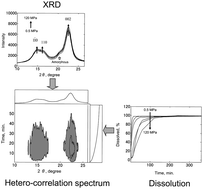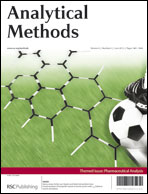Chemical and physical effects of the compression process on cellulose excipients are explored by near infrared (NIR) spectroscopy, X-ray diffraction (XRD), dissolution test and water absorption test. A set of pharmaceutical tablets including pentoxifylline (PTX) and cellulose are prepared under varying levels of compression. The compressive deformation of the tablets is probed by NIR spectroscopy and XRD. The interaction of tablet with water molecules is also analyzed with the dissolution and water absorption tests. The essential relationship between the two different classes of data, e.g. XRD and dissolution (or absorption) test, is effectively elucidated by heterospectral two-dimensional (2D) correlation analysis. It revealed that the compression produces a disordered amorphous component of cellulose. Such development of the mobile amorphous phase results in a more tightly packed matrix with less porosity. Thus, in turn, it prevents penetration of water molecules into the tablet and direct contact with PTX, which eventually brings the delay in the dissolution. Consequently, by carrying out the hetero-correlation analysis of the two datasets, it effectively provided a more detailed picture of the compression process.

You have access to this article
 Please wait while we load your content...
Something went wrong. Try again?
Please wait while we load your content...
Something went wrong. Try again?


 Please wait while we load your content...
Please wait while we load your content...